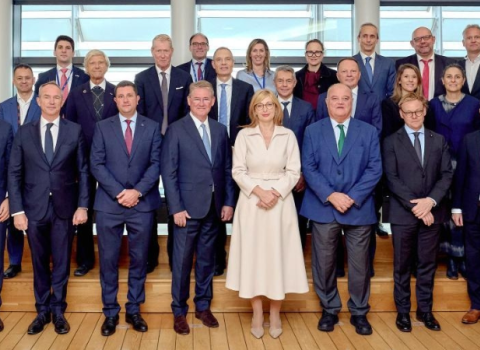Clean Aviation Joint Undertaking woos regional partners to achieve climate goals

The European Clean Aviation Joint Undertaking (JU) is eager to accelerate research and innovation and improve pan-European collaboration. The time required for the development, testing and certification of commercial aircraft technology mean the technologies that Europe will need to achieve its 2050 climate neutrality objectives should already be in the works and effectively need to hit the market by 2035.
Europe needs to move quicker to decarbonise aviation, according to several expert speakers at a recent workshop co-organised by European Commission DG Research and Innovation and the Clean Aviation JU in cooperation with the European Committee of the Regions. With that in mind, the JU and the Commission are playing urgent matchmaker with potential partners across Europe, said Joanna Drake, deputy director general of DG Research and Innovation. For the European aviation industry to remain competitive, “we need to be more joined up,” she said. “We are all convinced that Europe can do it, and will do it, if we put all our resources together.”
Giuliana Fenu, director of regional competitiveness for the Piemonte region in Italy, said it is imperative that Europe gets better at aligning on research and development goals within the aviation sector and strategising resources across regional, national and European instruments. “Otherwise, the United States, India and China will win,” she warned.
Other speakers also sounded a note of urgency. Valeria Fascione, minister for research, innovation and start-ups for Campania region, Italy said it is about to launch a €30 million call for projects. Some citizens “doubt that all this transformation is necessary now.” Because of that, she said, “It’s up to the EU to demonstrate—urgently—that taxpayers’ euros are being invested wisely to support the transformation.”
Axel Krein, executive director of the Clean Aviation JU, noted that the aviation sector is a key part of Europe’s economy: “It represents 13.5 million jobs in Europe, €1 trillion in economic activity and 4.4% of the EU’s gross domestic product,” he said. To cite just one example, Airbus in Hamburg delivers every sixth aircraft produced worldwide.
The Clean Aviation JU is the European Union’s leading research and innovation programme for transforming aviation towards a sustainable and climate neutral future. Marc Lemaitre, the European Commission’s director general for research and innovation, said: “With support from Horizon Europe, the Clean Aviation JU will deliver key disruptive aircraft technologies which will boost both the competitiveness and sustainability of the EU aviation industry.”
Synergies with national and regional initiatives are crucial
The JU has a public-private total budget of €4.1 billion for the period between 2021 and 2027. But Commission experts estimate that indicatively three times that volume of investments would be required by the end of this decade to transform the aviation sector in the EU. “That is why synergies with the relevant national and regional initiatives are crucial as they increase the impact in competitiveness and sustainability not only of projects funded at EU level but also from those funded by regional and national investments. We should build on this,” Lemaitre stated. However, some experts cautioned that synergies with member states and regions won’t be sufficient, considering the scale of transformation required.
“With the inherent long life cycle for aircraft, investing in aviation is investing for the long-term,” Krein added. “Strategic co-operations for net-zero aviation between the Clean Aviation JU and regions are supporting European competitiveness and jobs.”
The Clean Aviation JU aims to improve coordination between Europe’s many regional and industry initiatives. It goes well beyond high strategy, aspiring to create a series of detailed joint technical roadmaps that include synergies between regions and industry by design. “Synergies are about connecting the dots between different players to move forward faster together,” said Rosalinde van der Vlies, director of the Commission’s Clean Planet Directorate in DG Research and Innovation and Chair of the Clean Aviation Joint Undertaking’s Governing Board.
The JU says the benefits for the regions are clear: increased exploitation and internationalisation opportunities, development of skills and jobs in sustainable aviation.
In the past, start-ups have had to navigate a complex funding environment. María Ángeles Martín Prats, founder and president of Skylife Engineering, a spin-off of the University of Seville, said that when she founded the company in 2011, her initial focus was on obtaining regional support from the Andalusian government. When that initially failed to happen, she started applying for European research funding. After a couple of false starts, she began to better understand the process, identified potential partners, built consortia and started winning European research grants. The company, which specialises in high-tech power systems, now has 70 engineers on staff and works across several sectors including aviation, hydrogen fuel cells and fusion reactors. “European projects helped me find partners and build the company,” she said.
More Memoranda of Cooperation in the making
The Commission says Europe has at least 16 regions that describe themselves as having strengths in aviation, aeronautics and aerospace technologies. The workshop was intended, in part, to bring them all together to understand each other’s capabilities and priorities.
According to the JU, several European regions – including Occitanie, Piedmont and Campania – are already well aligned with the EU’s priorities on complementary activities under Memoranda of Cooperation (MoCs) with Clean Aviation, and the Clean Sky 2 Joint Undertaking led to 18 Memoranda of Understanding (MOUs) and 52 pilot projects.
Luca Bedon, head of R&T at GE Avio Aero, said that there are several fruitful collaborations between regional-funded projects in Piedmont and Clean Aviation (before Clean Sky 2) contributing to the next generation of clean aircraft engines. The fostered collaboration between the regional authorities and the JU under the Memorandum of Cooperation is expected to further enlarge the innovation ecosystem, in particular with increased contributions from SMEs.
At the workshop, Jalil Benabdillah, vice-president of Occitanie Region, said the collaboration with the Clean Aviation JU will increase the impact of the region’s Green Aircraft Plan, as it is also leveraging a coordinated approach with the French national programme CORAC. In light of the expected benefits, representatives from Hamburg and Andalucía said they are getting prepared to sign MoCs with Clean Aviation JU for closer cooperation with the EU and other partners.
Meanwhile, at the EU level, the Innovation Fund, European cohesion funds and regional development funds offer additional resources not specifically earmarked for clean aircraft innovations, but which can help achieve the dream of decarbonising aviation.
The future of the European Framework Programme
Looking at the future research and innovation programme, the so-called Framework Programme 10, the methodology “synergies by design” as worked out by Clean Aviation JU could offer a very interesting avenue to increase impact of EU projects results and accelerate the market penetration of innovative clean technologies.
“Synergies are at the cornerstone of European competitiveness. They are an efficient avenue for integrating European, national and regional research for accelerating the delivery of impact”, said Drake at the Commission. “They should, however, work better, also to more efficiently support deployment and market uptake of clean technologies in the aviation sector, as well as for in other sectors.”





 A unique international forum for public research organisations and companies to connect their external engagement with strategic interests around their R&D system.
A unique international forum for public research organisations and companies to connect their external engagement with strategic interests around their R&D system.